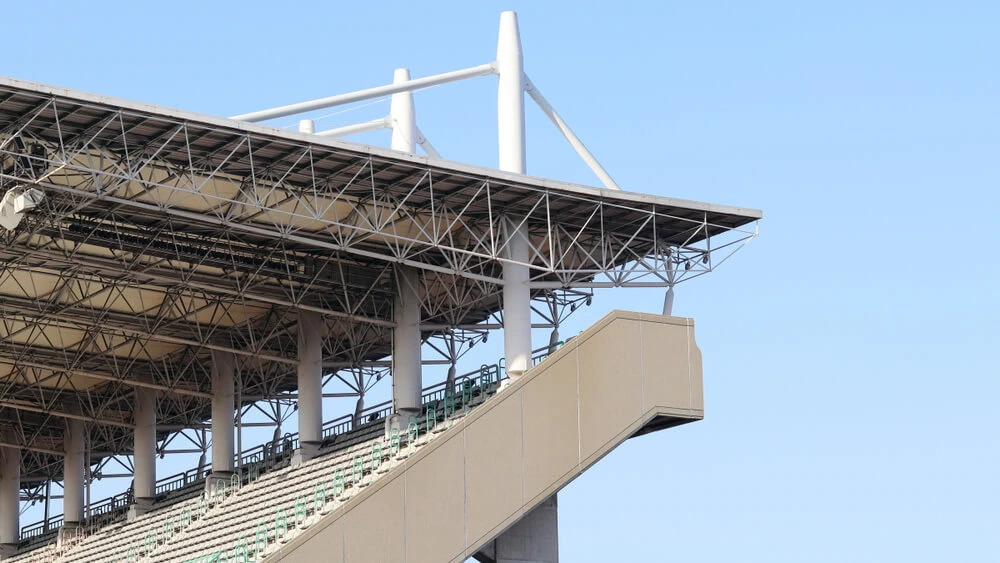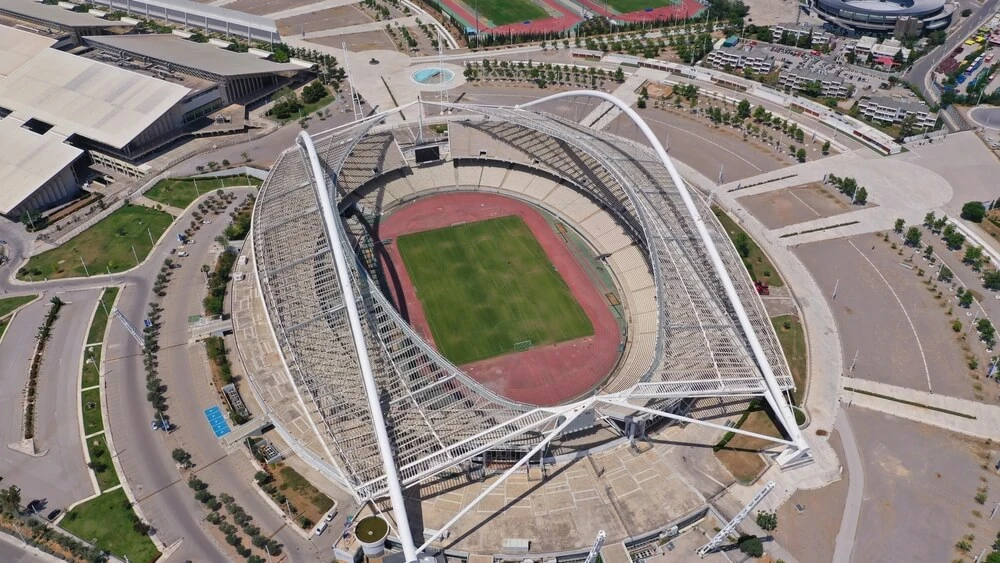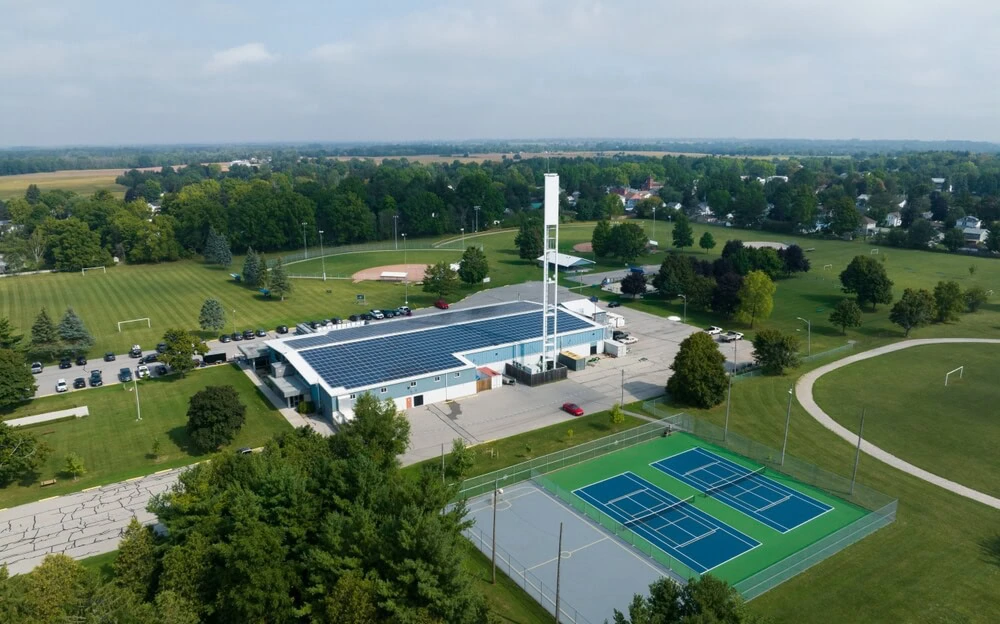Stadiums and sports facilities have some of the most entertaining live events. Championship games, sellout concerts, and conventions all draw thousands of people into one building where they can experience a live performance together. But, these buildings need to be safe and protected against the weather. That’s a tall order.
Stadium and sports facility roofing is an animal of its own. The structures are often specially designed, and the materials used can be unique. This guide on roofing for stadiums and sports facilities will highlight some of the factors that make these structures so interesting.
Stadium Roof Design Considerations
When it comes to stadium roofs and sports facilities, the buildings themselves run the gamut from multimillion-dollar entertainment venues to repurposed warehouses. Because it’s such a wide range of facility types, there are several design factors to consider.
Roof Structure
Stadium and sports facilities often (if not typically) have roofs that are a critical part of their design. They have unique structural needs, determined and designed by architects and engineers, becoming an integral part of the structure’s overall look.
On a smaller scale, like large repurposed buildings, steel buildings, and other sports facilities, the roofing structures are relatively basic. Their structures usually consist of steel trusses and beams supporting flat or low-slope roofs.
Regardless of the building type and its design, these structures have to be extremely strong. They carry the load of snow, resist wind, and might even support mechanical equipment. Both structural types span long distances, making it important that they’re designed to resist sagging.
Retractable Roof
Retractable roofs are in a league of their own, but they’re still worth mentioning. These roofs are made up of retractable panels that open and close to allow natural light into the stadium, keep the inner air temperature more comfortable, protect the crowd from the elements, and allow the stadium to be usable year-round.
These roofs are incredibly complex and require teams of engineers and designers to develop a functioning roof system. Even more complicated than the design process is the installation, requiring specialized equipment and installation techniques.

Sports Facility and Stadium Roofing Types
There are plenty of unique arenas and stadiums around the country, and each might have its own special materials or elements. However, most of these structures use the same handful of materials, often in combination. The following are the most common materials used for these structures.
Steel
Steel is the most common material when it comes to the structure of the roof, but it’s also a common roofing material. It’s strong, durable, and long-lasting. It’s common on warehouses and steel buildings, but it might also be used for sections of larger stadium roofs as well.
Ethylene Tetrafluoroethylene (ETFE)
ETFE is a lightweight, transparent plastic material that can be used on large roofs on buildings that require natural light. It’s highly durable and is resistant to harsh weather conditions. It’s also self-cleaning, requiring little maintenance.
Polyvinyl Chloride (PVC)
PVC is a type of plastic membrane that’s highly resistant to UV rays, weather, and chemicals. It’s lightweight and relatively easy to install, reducing the construction period required. It’s also typically reflective, which could result in decreased cooling costs in hot climates.
Ethylene Propylene Diene Monomer (EPDM)
EPDM is a single-ply material that’s easy to use and lasts around 30 years. It’s flexible in a wide range of temperatures, making it a great choice for climates that experience weather extremes. It’s also highly recyclable, making it a fan favorite for sustainability purposes.
Thermoplastic Polyolefin (TPO)
Like PVC and EPDM, TPO is another type of single-ply roofing membrane. It’s energy-efficient and heat-reflective, saving cooling costs. It’s also very durable and resistant to UV rays, and it’s one of the more affordable roofing materials for commercial buildings and entertainment and sports venues.
Other Materials
Other materials are frequently used in these structures, as well. They include concrete for the structure itself, polycarbonate sheeting for its translucence, and even glass. Some structures might even feature green roof systems.
Climate and Location Considerations
Stadiums and sports facilities are exposed to a wide range of weather conditions throughout the year. They withstand heavy rain, snow, and extreme temperatures. Whatever the chosen roof material might be, it needs to be able to resist these elements, along with wind, hail, and other hazards.
It’s also worth noting that these large structures can be expensive to heat and cool, so it’s important to choose the right material for the climate. For example, colder climates might opt for a black EPDM roof, as it would help absorb some heat in the winter. Conversely, warmer climates might require a membrane that reflects sunlight, keeping the building cooler in the hotter months.
Sustainability and Energy Efficiency
Stadiums, domes, and sports facilities can be very difficult to control from a comfort standpoint, and they also consume a lot of electricity. But, smart design can help reduce the building’s carbon footprint and energy consumption.
Energy-Efficient Design
Energy efficiency should be a priority, even early in the design process. Using the right materials to absorb or reflect the energy will help reduce the amount of resources consumed to heat or cool the building. Similarly, including enough daylight features like skylights and retractable panels allow these spaces to use less energy during the day.
Some sports facilities and stadiums can even be outfitted with solar panels, green roofs, and other sustainably-minded design choices.
Natural Light and Ventilation
During the day, natural light is often the preferred light source for creating a comfortable and enjoyable atmosphere and fan experience. Some stadiums might also feature operational panels that allow for ventilation to avoid a stuffy environment. The combination of these can help reduce energy consumption and improve the building’s sustainability, reducing the need for electricity for lighting or air exchanging equipment.

Installation and Maintenance Considerations
When it comes to installing a new roof on a sports facility or replacing an old roof, or maintenance in either case, there are a handful of points to think about.
Installation Challenges
Stadiums and sports facilities are generally busy places. Even in off-seasons, these facilities are typically used for other events or even another sport. It’s important to plan for the time required to work on the building and install or replace the roofing system. Depending on the size, this could take a week or more (in some cases, much more) to accomplish.
Single-ply roofing systems are the fastest and easiest ways to cover a stadium or sports facility roof, depending on the design and style. Metal is also a good choice. Both of these materials are installed relatively quickly and can protect the building in a short period of time, allowing the building to get back to entertaining visitors.
Maintenance Considerations
Maintenance is another point to straighten out. Any roofing system, whether it’s brand new or a few years old, will need preventive maintenance. Regular inspections, debris cleaning, and small repairs are critical to ensuring the roof lasts as long as possible.
These buildings are often too large and complex for a building owner to maintain the roof themselves. We suggest contacting Nations Roof, as we offer roof management, complete with preventive maintenance schedules to keep your roping system (and its warranty) in excellent shape for its lifetime.
Contact Nation’s Roof today for your free inspection.



